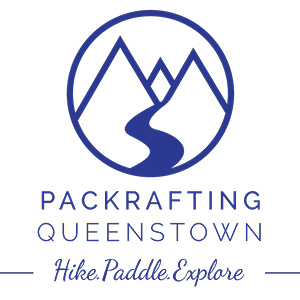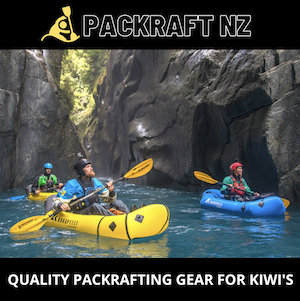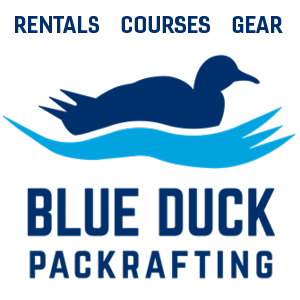The gorge of Te Awa Kairangi / Hutt River is a spectacular trip through native forest with a real wilderness feel. It is well known by local paddlers, as it is the closest class III water to Wellington (one hour) and has road access with a short shuttle.
Te Awakairangi / Hutt River supplies Wellington with much of its water so it suffers from summer low flows. It’s best after rain and needs a northwest fresh or sustained southerly rain to be runnable. The proximity to town and ease of access mean that it’s also well known to search and rescue. One rapid was known as the “Westpac” after the rescue helicopter. In low summer flows many under-equipped parties swim/lilo/tube the gorge. But it is longer than you think and many rescues are due to late starts, slow progress and it getting dark. In high flows it is serious water, so not one to underestimate!
Thanks to Martin Robertson for the information and photos.
Shuttle
Although making a loop trip by walking the ridge then packrafting back to your car is a great day out, it is pretty easy to do a car shuttle if you prefer.
The take out is a short distance from SH2 accessed via the Te Marua Speedway entrance to the Twin Lakes area of Kaitoke Regional Park. Continue to the service building and compound and then down to the left to the riverside car park.
From the take out it is 20 minutes (9km) via SH2 to the put in. On weekends hitchhiking prospects are reasonable but a modest walk (1.5km) will probably be required back to SH2 from the takeout.
The Kaitoke Regional Park entrance is via Kaitoke waterworks road, and is well signposted as you approach Pakuratahi. The access road leads to a riverside car park . There is excellent camping and facilities half way in and you can visit a Lord of the Rings setting (Rivendell).
Info about the access and camping can be found on the Greater Wellington Regional Council website . The put in is beneath the road bridge at the Pakuratahi Forks or 200m further up the river if flow permits.
Ridge Track. Twin Lakes to Pakuratahi Forks
From the Twin Lakes take out, follow the road up and around to the start of the Ridge Track. This is a pleasant track through typical Tararua forest, with some nice views along the ridge top.
You will notice there are two tracks which can be used as emergency exits from the gorge. It is worth familiarizing yourself with the map although the exit tracks are well marked and visible from the river. At a pinch any leading ridge on river left will do. The Ridge track time is 3 hrs, but a fit packrafter can do it without much trouble in 2hrs.
The local council have produced a sketch map of the access which could complement the topomap.
Te Awa Kairangi / Hutt River Gorge (III to IV)
The river is a popular tubing trip at low flows but there are a number of drops that would be pretty boney in a packraft below the recommended minimum flow (6.5cumecs).
The first section of the river has Class II rapids connecting a series of popular swimming holes. When the flume bridge comes into view you are approaching the last easy exit and a series of Class II+ III rapids. At the flume bridge you can exit by a steep scramble and walk a back along the road to your car.
Beyond the Flume bridge the river narrows within the gorge and gradient steepens. The first rapid “Under the Bridge” (100m past the bridge) give’s a taste of things to come. As you turn left there are then a series of rapids including “the Sisters” and “Gerry’s Drop”. Somewhere in the sequence are what Egarr called the “Pinball” and “Anne’s Drop” (which is no longer even a rapid of note).

These narrow rapids are formed by constrictions and so they are where logs will end up after floods. The whole gorge is very susceptible to serious log-jams and these can form river wide obstacles and dangerous sieves.

Rapids should be scouted for logs after floods or if you haven’t recently run the gorge. It’s a good idea to check in with local canoe club via Facebook for any recent trip reports that might highlight hazards. Portaging with packrafts should be possible at most rapids.
After a calm pool comes “the Weir” which is a river wide log that now has a bed of gravel behind it. It’s a small drop that is fun to play on.

After a calm reach the track swings sharply left past the first emergency exit up a ridge opposite where Putaputa Stream enters. The gradient steepens again and I call the first rapid “No Exit” to celebrate the fact you have just committed to the best sequence of rapids on the river. This leads into a wonderful long rock garden (I call “Goodbye Pork Pie”) that pushes you into the “Chicane” rapid. Eddy out for a breather as the next few rapids are amongst the best on the river.

The “Double Drop” is a series of drops. There is a nice flat top rock on river right for photo opportunities. Double Drop is followed by some smaller rapids and then a large rock on river right heralds the “Toilet Bowl”.

The best route in a packraft seems to be to flush around the rim and avoid the hole in the middle.
The Log Drop rapid described in old trip reports is no longer present. However there are a number of places where logs form weirs and these logs can move after a high flow.
There are still heaps of great rapids below this but none are named. There are lots of small drops and chutes with Grade III water to keep you entertained between pool sections.
Opposite two streams on river left, and facing a big slip, is a nice shingle beach for a halfway stop. After a few nice rapids there is a long flat pool. that ends in a jumble of small logs on river left and a horizon line. The horizon line is a lovely half metre weir formed by a submerged log. It seems logical to call this one “Big Log” (yes i’m using song names if you haven’t worked it out). A rock on river left affords a good photo opportunity.

A second emergency exit follows on river left (for those who’ve popped a warehouse raft and got cold in their speedos). If you’ve packrafted this far stick to the river it’s quicker.
A short distance on, Kororipo Stream enters on the right providing boulders for some more rock gardens. Beyond this there is an easing of gradient. The valley skyline visibly widens half an hour before the take-out. This section is class II at the recommended flow.
The take-out is an obvious gravel beach. You will have been on the river 3 hours at this point covering 9.5km at a gradient of 7.5m/km. Running the gorge with no stops or eddying takes about 2 hours but this can only be done if you know from recent knowledge that there are no new logs. Shore scouting is essential above 10m3. Below 6m3 it can also be hazardous where logs and drops don’t have enough water.
View Larger Topographic Map
The Te Marua gauge was retired years ago but is now ‘derived” by subtracting the Akatarawa and Mangaroa flows from the Birchville gauge. There is a Kaitoke gauge which can be checked to see if the river is rising or falling. It rises in a few hours after rain. As with all Tararua Gorges watch a few storm cycles and the river response to understand when the river flow is in the Packrafting window. It can be hazardous on a low flow with logs and rocky drops that must be portaged.
The Te Marua gauge derived flow should be above 6m3, with a flow of 10m3 being perfect. Beyond 30m3 the river has Class IV water with numerous holes and can be very pushy. Gerry’s Drop, the Double Drop and Toilet Bowl in particular will be too heavy for a Packraft to punch through above 15 to 20m3, Unless dropping onto Packraft eating holes is your thing paddle in the 5m3 to 15m3 window.

There are a number of videos on YouTube showing the main rapids at a range of flow conditions. It’s worth checking these to see what you might be in for. This (long) video shows a flow of < 10m3 which is the perfect packraft flow.






